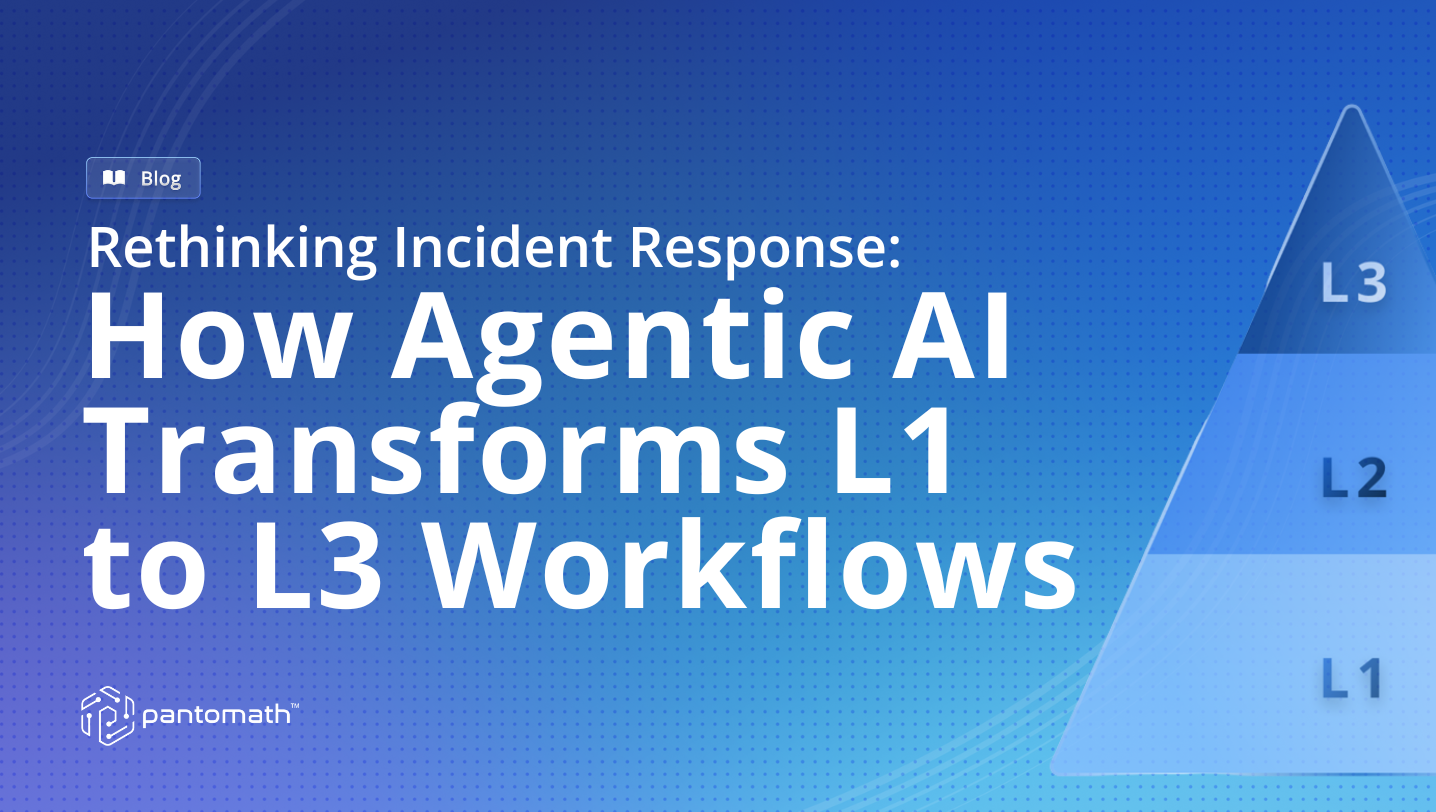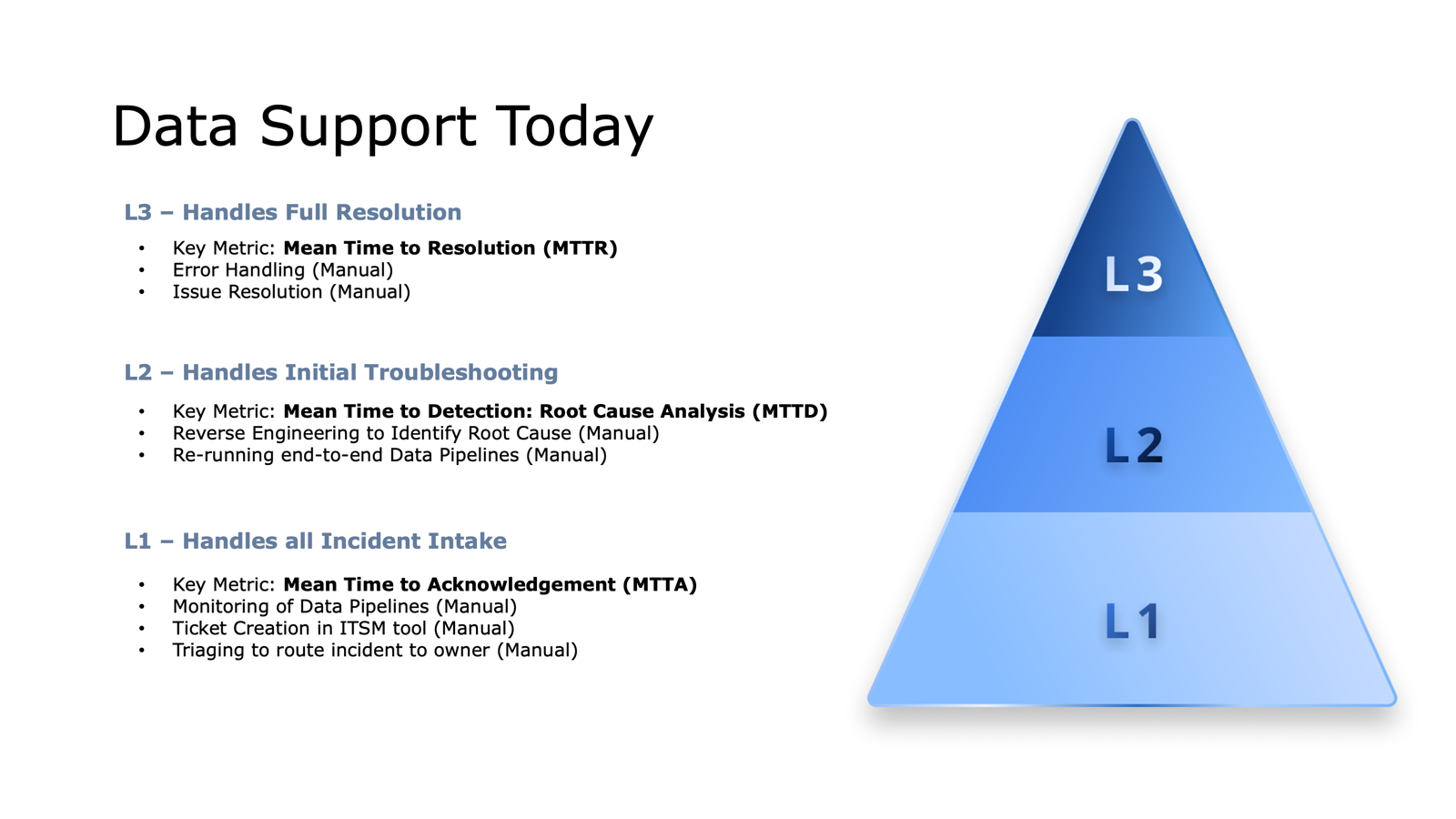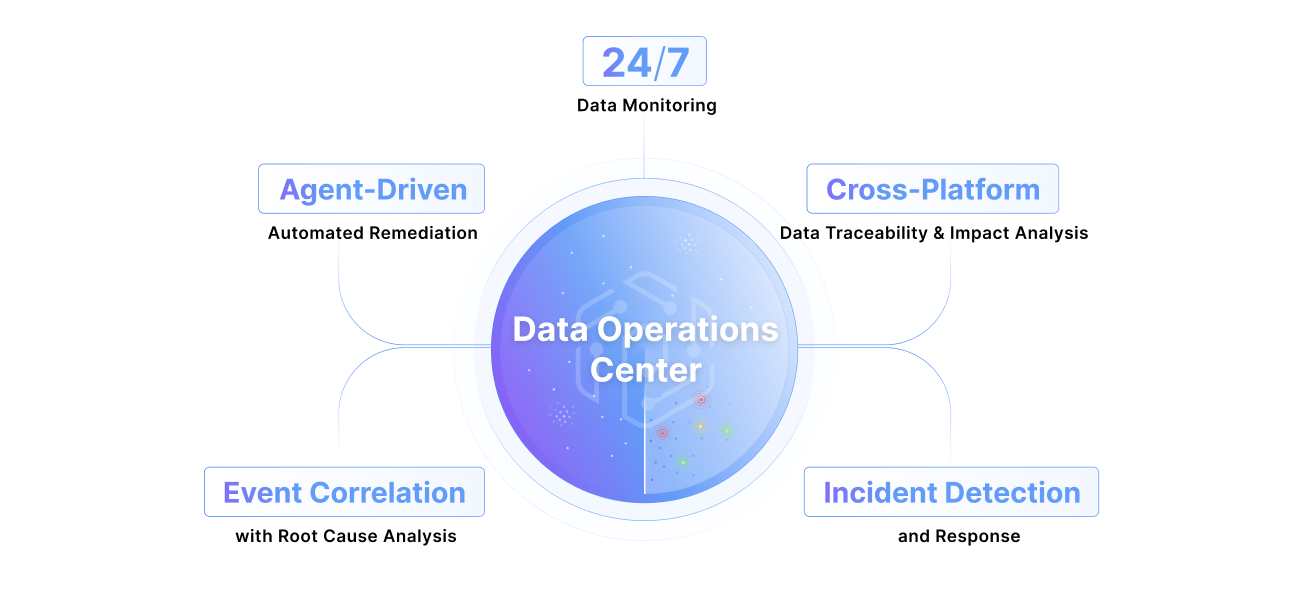
Discover how Agentic AI transforms L1–L3 incident response, automating root cause analysis and streamlining data operations across the enterprise.
Rethinking Incident Response: How Agentic AI Transforms L1 to L3 Workflows
It’s the middle of the night and your data platform has collapsed quietly. By the time L3 engineers pulled in, business dashboards are frozen, executives are firing off frantic messages, and your data team is desperately piecing together what happened. If this feels very familiar, you’re not alone.
Incident response, as we know it, is broken, maybe irreparably. We’re stuck in an era of endless pings and tickets, where overtaxed L1 teams drown in busywork and L3 engineers are chronically reacting. Mean time to recovery (“MTTR”) and other observability metrics are headed in the wrong direction. The ugly truth is that our “modern” workflows are antiques, as are the assumptions propping them up. Most organizations haven’t rethought their incident response hierarchy since the days of rule-based alerting.
Understanding L1 to L3 Today: The Pyramid That Can’t Keep Up

The typical incident response pyramid was built for a world that no longer exists:
- L1 Teams are stuck on the front lines, triaging tickets
- L2 Teams struggle valiantly through siloed systems without cross-platform clarity
- L3 Engineers play whack-a-mole, wasting their deep expertise on troubleshooting
If an upstream job hiccups and data goes missing, by the time L3 wakes up, business dashboards are already wrecking havoc. That launches a manual, cross-platform wild goose chase that can burn through hours or days.
This isn’t rare, it’s the norm. Recent research lays it bare: 90% of companies take hours, days, or even weeks to untangle pipeline messes, and a staggering 74% only find out when someone downstream spots the wreckage. A near-total collapse in trust in data is the ultimate result of this process.
The Limits of Automation Without Intelligence
Most automation in Data Operations is window dressing and a complete facade. Native tooling in your integration platforms might catch a failed job, but stay unaware of downstream ripple effects. Those tools can’t guide your teams to an actual fix, and are blind when it comes to anything more nuanced than a status alert.
Here is where these tools’ gaps turn into chasms:
- Integration tools see only their corner of the universe, oblivious to real business impact
- Integration tools don’t offer a real path to resolution, just a laundry list of failed components
- Monitoring is half-baked, with no self-healing, no context, and endless reliance on tribal knowledge and Slack chats
Incident response doesn't need better alerts; it needs better agents running on accurate data.
The Agentic AI Revolution
Agentic AI represents a fundamental shift in how we approach incident response. Unlike traditional monitoring that simply sends alerts, agentic AI perceives, decides, and acts. It doesn't escalate; it resolves.
Here’s what the revolution looks like in practice:
- Intelligent monitoring: Platforms like Pantomath have wiped out manual setup, delivering automatic, comprehensive monitoring across every data asset.
- Dynamic understanding: Modern pipeline intelligence doesn’t just register failure; it understands the whole end-to-end analytic stack, uncovering subtle, cross-system dependencies that trip up classic tooling.
- Contextual resolution: When trouble hits, impact is mapped immediately—right down to which downstream users or BI dashboards are affected. You get a guided, stepwise resolution path, not a spreadsheet of headaches.
- Autonomous action: The system doesn’t just alert; it files the ticket, assembles the evidence, and can execute the fix, rerunning what needs to run and restoring pipelines proactively.
L1 -> L3, Before and after Pantomath
Take Franciscan Health, a 12-hospital integrated care system. Data flows through dozens of platforms, from EMR systems and ERP applications to analytics dashboards and flat-file exchanges with external partners.
Pre-Pantomath, data issues might surface; from the CFO noticing inconsistencies to clinical teams seeing outdated metrics. Investigations crawled through days of email, manual checks, and frustration. IT was perpetually on its back foot. Fixes took the form of what Sarang Deshpande, VP of Data and Analytics, describes as "band-aids on top of band-aids."
Post-Pantomath, automated, real-time monitoring brings problems to light instantly, notifying all the right players, and pinpointing root causes before they reach critical systems. Manual digging that once took days now happens in hours, if at all.
The data team has gone from reactive to considering ambitious future possibilities. According to Deshpande, “I've been a great fan of everything we've been able to do [with Pantomath]. How quickly bugs get resolved. We’re already thinking, what more can we do?”
Why Agentic Revolution Matters Beyond Tech
The benefits of agentic AI in incident response extend far beyond the technology sector. For example:
Healthcare: With agentic AI, healthcare organizations instill patient data integrity and maintain compliance with critical regulations while reducing operational overhead.
Financial services: One Fortune 250 bank slashed detection and resolution times, alerting only the right teams, guarding compliance, and safeguarding customer trust.
Manufacturing: Many manufacturing operations require automated data operations. Even with global operations across several different countries, agentic AI can help manage the complex flow of information into a streamlined system.
24/7 Operations: Across the board, companies can cut operational costs by 40-60%, eliminate data guesswork, and make decisions in real time, rather than in crisis mode with agentic AI.
What Makes Agentic AI Possible Today?
Several technological advances have converged to make truly agentic data operations possible. These advances include:
- True, metadata-level lineage: Platforms like Pantomath map every dependency and relationship end-to-end, unifying job lineage with data flows down to the granular level.
- RAG-driven architecture: Advanced retrieval-augmented generation (RAG) frameworks in enterprise data catalogs now allow AI agents to detect, explain, and auto-resolve issues in milliseconds.
- Total observability: From data at rest to data in motion, the observability pyramid is finally fully instrumented.
- Self-healing: Circuit breakers, preemptive job pausing, and automated reruns ensure nothing slips through and that SLAs are met.
Agentic AI is the New Baseline
The old escalation ladder is obsolete. In a world where 91% of enterprises expect generative AI to be key to their data strategies within the next 3 to 5 years, our incident response models must evolve accordingly.
True agentic AI acts with purpose, closing the feedback loop, and frees teams from endless triage. The L1-L3 world had its moment. But in today’s organizations, the only real choice is intelligence that acts.
Looking for for proactive vs reactive incident management? Set up time to speak with us here.
Keep Reading
.png)
October 28, 2025
Pantomath Achieves ISO/IEC 27001:2022 CertificationPantomath announced today that it has achieved ISO/IEC 27001:2022 certification for its Information Security Management System (ISMS).
Read More
September 30, 2025
Why Data Teams Need Unified SchedulingData operations don’t fail because of tools, they fail because they’re fragmented. A unified scheduling view brings order, reliability, and confidence - see how.
Read More.png)
September 25, 2025
Why Observability at Ingestion is Crucial for Data Trust & ReliabilityData reliability issues start earlier than you think. Learn why observability at ingestion is the foundation of trust and how proactive monitoring and automation change the game.
Read More







